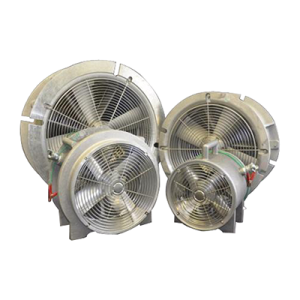Jet Fans & Swing Gates
Why is it called a Jet Fan?
These four-bladed vaneaxial fans are called Jet Fans because a high velocity jet of compressed air is ejected from the trailing edge of the fan blade. This results in the forward rotation of the fan blade just like a jet plane is pushed forward by the high velocity air ejected from the rear of the jet engine.
- Use for general ventilation in any location where compressed air is available. Use as blower or exhauster.
- Suited for ventilation of tanks, process vessels, or other confined spaces for the removal of hazardous fumes or contaminated air from welding, sandblasting and other operations.
- Rated operating pressure 40-110 PSI.
- Hi-tech four blade design allows for lower RPMs while still moving more air.
- Bearings are packed with a hi-tech synthetic lubricant for longer life.
- Fan Blades are precision balanced.
- Electro polished stainless steel fan guards.
- Castings are heat treated to T6 aircraft aluminum specifications.
- Super-duty, high quality, high pressure air seal for longer service.
- Heaviest-duty fans in the industry.
- Guide vanes eliminate turbulence which smooths air flow and increases effeciency.
- Fans design by one of the foremost fan engineers in the world.
- Sometimes referred to as “Coppus Blowers”
Special Features of the Texas Pneumatic Jet Fans
- The unit consists of a rugged cast-aluminum housing and a cast-aluminum fan blade.
- The shaft, bearings and fan blade are the only rotating parts. There is no torque on the shaft, as it does not transmit any power to the fan blade, as shafts normally do. The compressed air jets on the trailing edge of the blade drive the fan.
- The fan has a hub and four blades which produce adequate static pressure to overcome the resistance of the system to be ventilated.
- Only two of the four blades have jet outlets. All have airfoil cross sections for higher flow rates.
- The housings are equipped with guide vanes for better efficiency. The guide vanes neutralize the air spin past the blades and guide the air flow into an axial direction.
- The housings have a smooth inlet bell for increased CFM, higher efficiency, and lower noise levels.
- Performance tests were conducted at a independent test lab to AMCA Standard 210.

